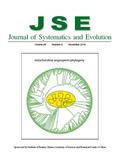Yin-Long QIU, Libo LI, Bin WANG,Jia-Yu XUE, Tory A. HENDRY, Rui-Qi LI, Joseph W. BROWN, Yang LIU, Geordan T. HUDSON, Zhi-Duan CHEN
An angiosperm phylogeny was reconstructed in a maximum likelihood analysis of sequences of four mitochondrial genes, atp1, matR, nad5, and rps3, from 380 species that represent 376 genera and 296 families of seed plants. It is largely congruent with the phylogeny of angiosperms reconstructed from chloroplast genes atpB, matK, and rbcL, and nuclear 18S rDNA. The basalmost lineage consists of Amborella and Nymphaeales (including Hydatellaceae). Austrobaileyales follow this clade and are sister to the mesangiosperms, which include Chloranthaceae, Ceratophyllum, magnoliids, monocots, and eudicots. With the exception of Chloranthaceae being sister to Ceratophyllum, relationships among these five lineages are not well supported. In eudicots, Ranunculales, Sabiales, Proteales, Trochodendrales, Buxales, Gunnerales, Saxifragales, Vitales, Berberidopsidales, and Dilleniales form a basal grade of lines that diverged before the diversification of rosids and asterids. Within rosids, the COM (Celastrales–Oxalidales–Malpighiales) clade is sister to malvids (or rosid II), instead of to the nitrogen-fixing clade as found in all previous large-scale molecular analyses of angiosperms. Santalales and Caryophyllales are members of an expanded asterid clade. This study shows that the mitochondrial genes are informative markers for resolving relationships among genera, families, or higher rank taxa across angiosperms. The low substitution rates and low homoplasy levels of the mitochondrial genes relative to the chloroplast genes, as found in this study, make them particularly useful for reconstructing ancient phylogenetic relationships. A mitochondrial gene-based angiosperm phylogeny provides an independent and essential reference for comparison with hypotheses of angiosperm phylogeny based on chloroplast genes, nuclear genes, and non-molecular data to reconstruct the underlying organismal phylogeny.

